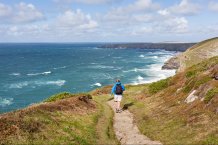Articles

Around 271 million recreational visits a year are made to English coastlines.
270 million visits made to English coastlines each year
Research has revealed for the first time that around 271 million recreational visits are made to marine and coastal environments in England.
Conducted by the University of Exeter Medical School and published in the journal Marine Policy, the research found that the most common activity on these visits is walking.
The study also revealed that most people head to these ‘blue’ environments for relaxation and social reasons.
Whilst walking (either with or without a dog) was the most popular activity, the analysis showed that coastal walks were more likely to be made by females and older adults, suggesting the coast may play a particular role in supporting physical activity in these groups.
A growing body of research has shown links between spending time in nature and improvements in health and wellbeing (e.g. http://bit.ly/2DJedJz). The findings of this latest study demonstrate the importance of the UK’s coasts for health and wellbeing at a time when the government is calling for greater protection of, and access to, natural spaces.
Other popular activities were sunbathing and paddling, taking place on a quarter of visits to the beach and amounting to 40 million dips a year. Seaside trips were not affected by socio-economic status however, hinting that spending time in these environments appeals to people across the social spectrum.
Dr Lewis Elliott, Environmental Psychologist at the University of Exeter and lead author of the study, believes the findings are important for the management of our coastal resources:
“We know that blue spaces can deliver significant benefits to health, wellbeing and the economy, yet no previous research has rigorously attempted to estimate their popularity for recreation, or considered the benefits they may have for public health. Our estimates have, for the first time, been able to quantify the importance of our beaches and coasts and we hope they will help planners make more informed decisions when considering the management of these natural spaces.”
The research team used data from the Monitor of Engagement with the Natural Environment (MENE) survey to produce their findings, investigating the characteristics of more than 326,000 nature-based visits from 2009 to 2016. They analysed the number of trips people made to different environments and what they did when they were there.
Based on this data, they could then estimate patterns at a national scale. More of the study’s highlights can be found on the following page.
Study Highlights
- 271 million recreational visits are made to coastal environments (beaches and coastlines) each year.
- 171.7 million annual recreational visits to beaches in England each year.
- 24% of all visits to beaches (41.4 million visits) involved sunbathing or paddling, the most popular water-based recreational activity undertaken at beaches.
- Other water-based activities were undertaken substantially less often with swimming outdoors taking place on 5.6 million visits, water sports on 3.7 million visits, and fishing on 1.8 million visits.
- 99.3 million visits were made to ‘other coastline’ environments each year, such as cliff paths for example.
- ‘Sunbathing or paddling’ was the most popular water-based activity at the coast, undertaken on 11.1 million visits.
- In both coastal settings, the most popular activities undertaken were walking, either with or without a dog, conducted on 123.7 million beach visits annually, and on 78.2 million other coastline visits.
This work was conducted as part of the BlueHealth project which received funding from the European Union’s Horizon 2020 research and innovation programme under grant agreement no. 666773. You can read the full paper here.
Watch Dr Lewis Elliott introduce the study here:
Date: 4 April 2018
